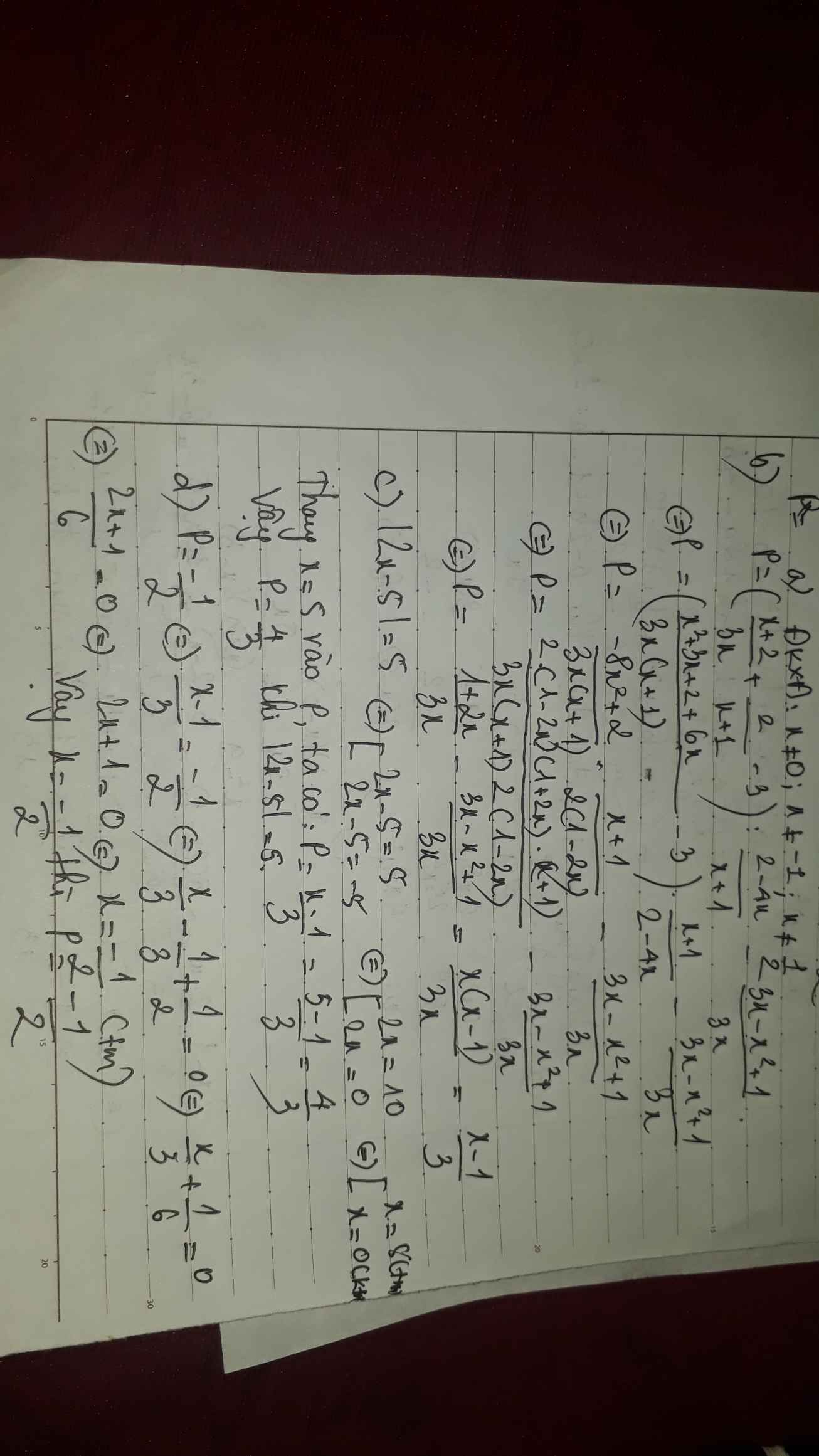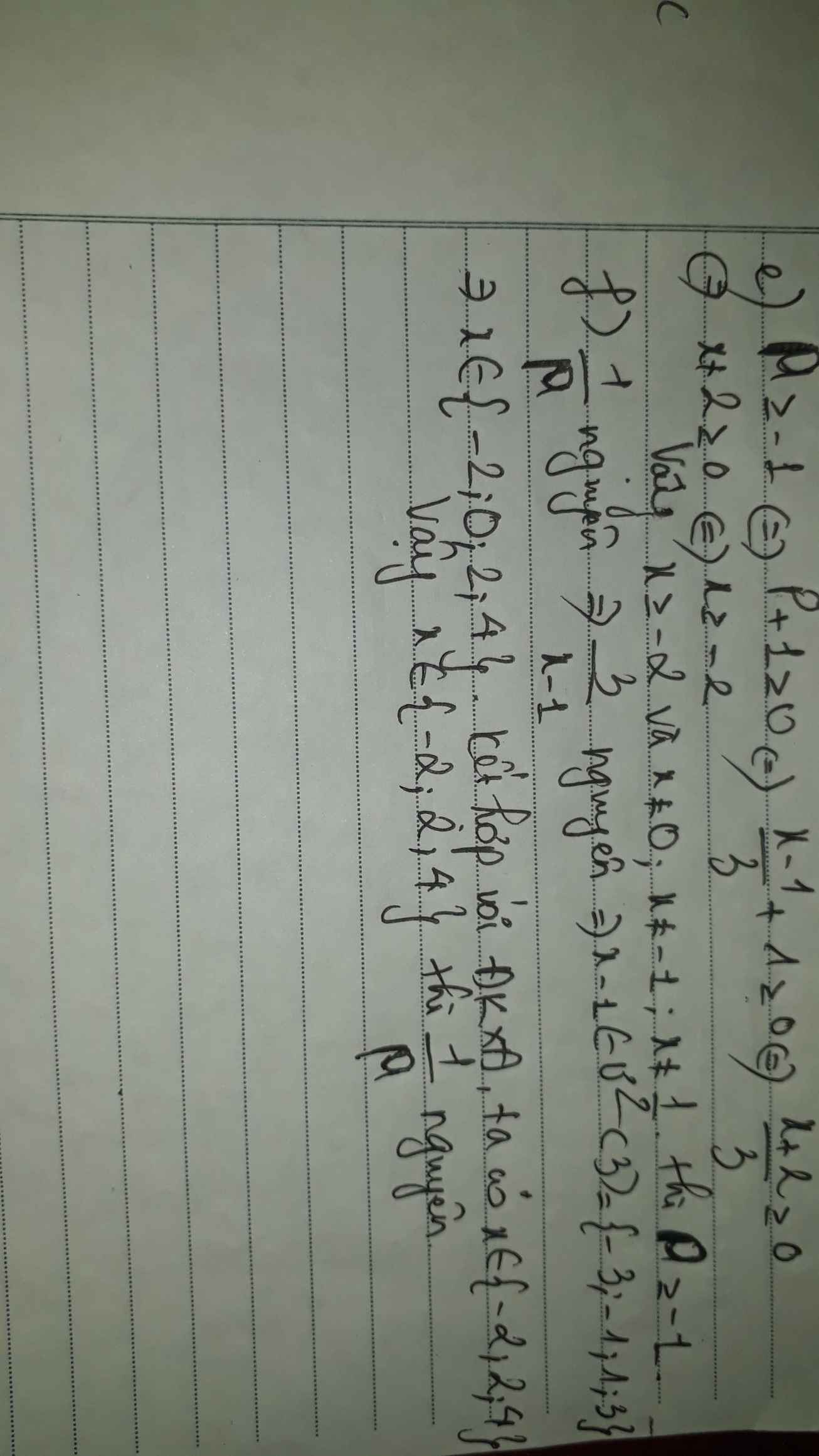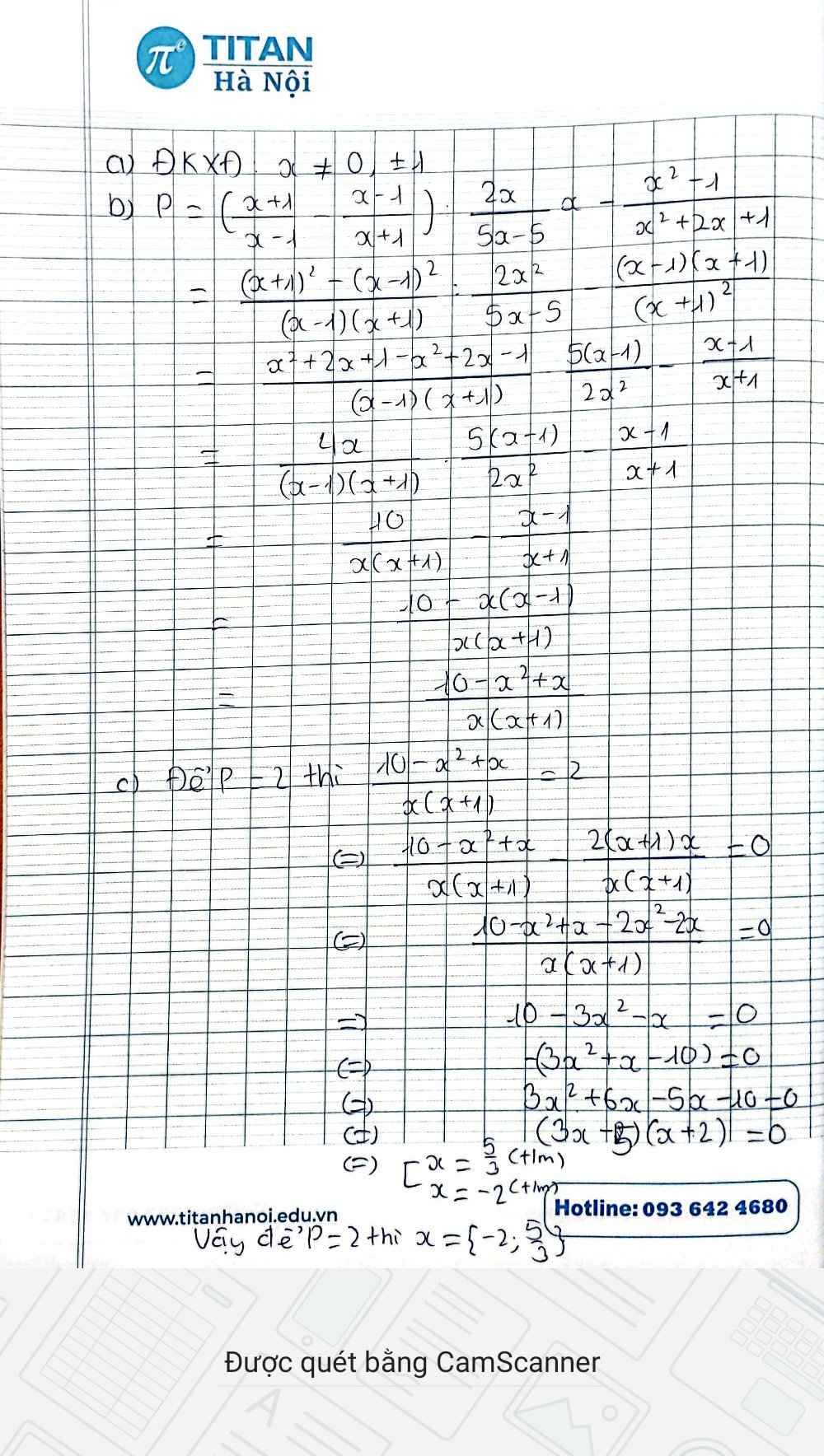Hãy nhập câu hỏi của bạn vào đây, nếu là tài khoản VIP, bạn sẽ được ưu tiên trả lời.

\(a,ĐK:x\ne\pm1\\ b,B=\dfrac{x^2+x-x^2-1}{2\left(x-1\right)\left(x+1\right)}=\dfrac{x-1}{2\left(x-1\right)\left(x+1\right)}=\dfrac{1}{2\left(x+1\right)}\\ c,B=-\dfrac{1}{2}\Leftrightarrow2\left(x+1\right)=-2\Leftrightarrow x+1=-1\Leftrightarrow x=-2\left(tm\right)\)

\(a,ĐKXĐ:\\ \left[{}\begin{matrix}x+1\ne0\\2x-6\ne0\end{matrix}\right.\Leftrightarrow\left[{}\begin{matrix}x\ne-1\\x\ne3\end{matrix}\right.\\ b,P=0\\ \Leftrightarrow\dfrac{3x^2+3x}{\left(x+1\right)\left(2x-6\right)}=0\\ \Leftrightarrow\dfrac{3x\left(x+1\right)}{3\left(x+1\right)\left(x-2\right)}=0\\ \Leftrightarrow\dfrac{x}{x-2}=0\\ \Leftrightarrow x=0\left(TM\right)\)
Vậy tại X=0 thì P=0
a) Để P xác định thì: \(\left[{}\begin{matrix}x+1\ne0\\2x-6\ne0\end{matrix}\right.\Leftrightarrow\left[{}\begin{matrix}x\ne-1\\x\ne3\end{matrix}\right.\)
b) \(P=\dfrac{3x^2+3x}{\left(x+1\right)\left(2x-6\right)}=\dfrac{3x\left(x+1\right)}{\left(x+1\right)\left(2x-6\right)}=\dfrac{3x}{2x-6}\)
Để \(P=0\) thì: \(\dfrac{3x}{2x-6}=0\)
\(\Leftrightarrow3x=0\)
\(\Leftrightarrow x=0\left(tm\right)\)

a) ĐKXĐ: \(x\ne-3,x\ne2\)
b) \(A=\dfrac{\left(x-2\right)\left(x+2\right)-5-\left(x+3\right)}{\left(x+3\right)\left(x-2\right)}=\dfrac{x^2-x-12}{\left(x+3\right)\left(x-2\right)}=\dfrac{\left(x+3\right)\left(x-4\right)}{\left(x+3\right)\left(x-2\right)}=\dfrac{x-4}{x-2}\)
c) \(A=\dfrac{x-4}{x-2}=\dfrac{3-4}{3-2}=-1\)

a: ĐKXĐ: x<>0; x<>5; x<>5/2; x<>-5
b: \(M=\left(\dfrac{x}{\left(x-5\right)\left(x+5\right)}-\dfrac{x-5}{x\left(x+5\right)}\right):\dfrac{2x-5}{x\left(x+5\right)}\)
\(=\dfrac{x^2-x^2+10x-25}{x\left(x-5\right)\left(x+5\right)}\cdot\dfrac{x\left(x+5\right)}{2x-5}=\dfrac{1}{x-5}\)

1) \(\dfrac{5-x}{x^2-3x}=\dfrac{5-x}{x\left(x-3\right)}\left(đk:x\ne0,x\ne3\right)\)
2) \(\dfrac{3x}{2x+3}\left(đk:x\ne-\dfrac{3}{2}\right)\)

a) ĐKXĐ: \(x\notin\left\{0;-5\right\}\)
b) Ta có: \(B=\dfrac{x^2+2x}{2x+10}+\dfrac{x-5}{x}+\dfrac{50-5x}{2x\left(x+5\right)}\)
\(=\dfrac{x\left(x^2+2x\right)}{2x\left(x+5\right)}+\dfrac{2\left(x+5\right)\left(x-5\right)}{2x\left(x+5\right)}+\dfrac{50-5x}{2x\left(x+5\right)}\)
\(=\dfrac{x^3+2x^2+2\left(x^2-25\right)+50-5x}{2x\left(x+5\right)}\)
\(=\dfrac{x^3+2x^2+2x^2-50+50-5x}{2x\left(x+5\right)}\)
\(=\dfrac{x^3+4x^2-5x}{2x\left(x+5\right)}\)
\(=\dfrac{x\left(x^2+4x-5\right)}{2x\left(x+5\right)}\)
\(=\dfrac{x^2+4x-5}{2\left(x+5\right)}\)
\(=\dfrac{x^2+5x-x-5}{2\left(x+5\right)}\)
\(=\dfrac{x\left(x+5\right)-\left(x+5\right)}{2\left(x+5\right)}\)
\(=\dfrac{\left(x+5\right)\left(x-1\right)}{2\left(x+5\right)}\)
\(=\dfrac{x-1}{2}\)
Để B=0 thì \(\dfrac{x-1}{2}=0\)
\(\Leftrightarrow x-1=0\)
hay x=1(nhận)
Để \(B=\dfrac{1}{4}\) thì \(\dfrac{x-1}{2}=\dfrac{1}{4}\)
\(\Leftrightarrow x-1=\dfrac{1}{2}\)
hay \(x=\dfrac{3}{2}\)(nhận)
Vậy: Để B=0 thì x=1 và Để \(B=\dfrac{1}{4}\) thì \(x=\dfrac{3}{2}\)

a: ĐKXĐ: \(3x^2+6x\ne0\)
=>\(x^2+2x\ne0\)
=>\(x\cdot\left(x+2\right)\ne0\)
=>\(x\notin\left\{0;-2\right\}\)
b: ĐKXĐ: \(x^3+64\ne0\)
=>\(x^3\ne-64\)
=>\(x\ne-4\)
c: ĐKXĐ: \(x^2-1\ne0\)
=>\(x^2\ne1\)
=>\(x\notin\left\{1;-1\right\}\)



a) ĐKXĐ: \(x\ne-7\)
b) ĐKXĐ: \(x\in R\)
a) Để giá trị của \(\dfrac{2x^2+7}{3x+21}\) được xác định thì 3x + 21 \(\ne\) 0
=> 3(x+7) \(\ne\) 0
=> x+7 \(\ne\) 0
=> x \(\ne\) -7
Vậy để giá trị của biểu thức \(\dfrac{2x^2 +7}{3x+21}\) được xác định thì x \(\ne\) -7
b) Để giá trị của \(\dfrac{x+5}{-12+6}\) được xác định thì x \(\in\) R ( vì -12+6 \(\ne\) 0)